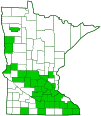American gromwell
(Lithospermum latifolium)
Conservation • Description • Habitat • Ecology • Use • Distribution • Taxonomy
Conservation Status |
|
|||||||
| IUCN Red List | not listed |
|||||||
| NatureServe | N4 - Apparently Secure SNR - Unranked |
|||||||
| Minnesota | not listed |
|||||||
Description |
||
American gromwell is a spring woodland wildflower. It occurs in the United States from New York to Minnesota, south to Virginia and Kansas, and in southern Ontario Canada. It is uncommon throughout its range, including in Minnesota. It mat be often overlooked due to the small size of its flowers and its similarity in appearance to other much more common plants. It is found in upland, moderately moist forests, woodlands, and thickets, usually on north-facing slopes; and on roadsides. It grows in rich, loamy soil under dappled sunlight in the spring, medium shade in the summer. Its presence is an indicator of a high quality woodland. American gromwell is an erect, perennial forb that rises on one or a few stems from a stout, somewhat woody taproot. It can be 16″ to 40″ tall, but in Minnesota it is usually no more than 30″ in height. The stems are erect and may be unbranched or have a few branches. They are moderately to densely covered with white, stiff, appressed, upwardly curved hairs. The leaves are alternate, ¾″ to 5½″ (2 to 14 cm) long, and 5⁄16″ to 2⅜″ (8 to 60 mm) wide. They are stalkless or on very short leaf stalks. The leaf blades are lance shaped to narrowly egg-shaped, angled or tapered at the base, and tapered to a sharp point at the tip. There are 3 or 5 lateral veins that arch strongly toward the leaf tip. They are conspicuously sunken on the upper surface and raised on the lower surface. The upper surface is dark green and rough to the touch. It is moderately covered with minute stiff hairs, and sparsely covered with longer spreading hairs. The lower surface is grayish-green and is moderately to densely covered with short, soft, fine hairs. The margins are untoothed. The inflorescence is a solitary flower on a short stalk in each of the upper leaf axils. Self-pollinating, closed, bud-like (cleistogamous) flowers are not produced. The flowers are 3⁄16″ to 5⁄16″ (5 to 8 mm) long and about ¼″ wide. There are 5 outer floral leaves (sepals), 5 petals, 5 stamens, and 1 style. The sepals (together the calyx) are green and are fused just at the base then separated for most of their length into 5 hairy, linear lance-shaped, 3⁄16″ to 5⁄16″ (5 to 8 mm) long lobes. The petals (together the corolla) are pale yellow to greenish-white. They are fused at the base into a narrow, ⅛″ to ¼″ (4 to 6 mm) long floral tube, then separated into 5 widely spreading, 1⁄32″ to 1⁄16″ (1 to 1.5 mm) long lobes. The corolla tube is no longer than the lobes of the calyx. The corolla lobes are not fringed. The stamens are inserted near the middle of the corolla tube. The style is 1⁄32″ to 1⁄16″ (1 to 2 mm) long. The fruit is a shiny, white, hard, egg-shaped, ⅛″ to 3 ⁄16″ (3.5 to 5 mm) long nutlet. It has a blunt ridge (keel) on the bottom. It may be smooth or have shallow scattered pits, mostly toward the base and along the keel. Each nutlet contains 1 seed. The calyx lobes persist and become 3 ⁄16″ to ½″ (5 to 8 mm) long and erect in fruit. |
||
Height |
||
16″ to 30″ |
||
Flower Color |
||
Pale yellow to greenish-white |
||
Similar Species |
||
Habitat |
||
Dry to moist. Upland, moderately moist forests, woodlands, and thickets, usually on north-facing slopes; roadsides. Dappled sunlight in the spring, medium shade in the summer. Rich, loamy soil. |
||
Ecology |
||
Flowering |
||
May to June |
||
Pests and Diseases |
||
|
||
Use |
||
|
||
Distribution |
||||
|
Sources |
|||
| 2/11/2023 | ||||
Nativity |
||||
Native |
||||
Occurrence |
||||
Uncommon |
||||
Taxonomy |
|||
| Kingdom | Plantae (Plants) | ||
| Subkingdom | Pteridobiotina | ||
| Phylum | Tracheophyta (Vascular Plants) | ||
| Class | Magnoliopsida (Dicots) | ||
Order |
Boraginales (borages) | ||
Family |
Boraginaceae (borage) | ||
| Subfamily | Boraginoideae | ||
| Tribe | Lithospermeae | ||
Genus |
Lithospermum (stoneseeds, puccoons, and gromwells) | ||
Subordinate Taxa |
|||
|
|||
Synonyms |
|||
|
|||
Common Names |
|||
American gromwell American stoneseed broad-leaved gromwell |
|||
Glossary
Axil
The upper angle where a branch, stem, leaf stalk, or vein diverges.
Calyx
The group of outer floral leaves (sepals) below the petals, occasionally forming a tube. Plural: calyces.
Cleistogamous
Automatically self-pollinating. Refers to bud-like flowers that do not open but automatically self-pollinate, or to plants with such flowers.
Corolla
A collective name for all of the petals of a flower.
Linear
Long, straight, and narrow, with more or less parallel sides, like a blade of grass.
Sepal
An outer floral leaf, usually green but sometimes colored, at the base of a flower.
Visitor Photos |
|||||
Share your photo of this plant. |
|||||
| This button not working for you? Simply email us at info@MinnesotaSeasons.com. Attach one or more photos and, if you like, a caption. |
|||||
Luciearl |
|||||
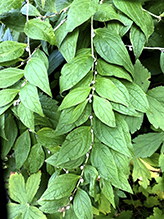 |
|||||
MinnesotaSeasons.com Photos |
|||||
Plant |
|||||
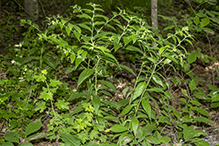 |
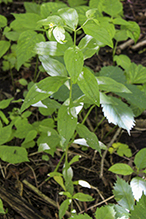 |
||||
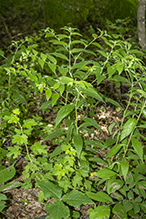 |
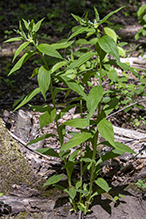 |
||||
Inflorescence |
|||||
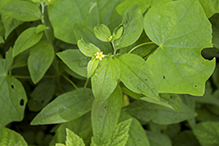 |
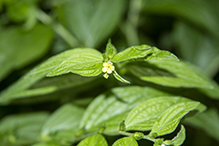 |
||||
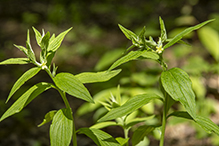 |
|||||
Flower |
|||||
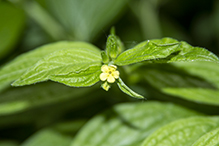 |
|||||
Leaves |
|||||
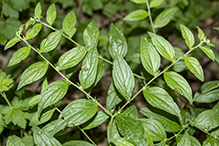 |
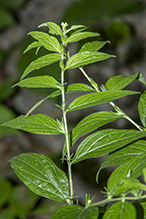 |
||||
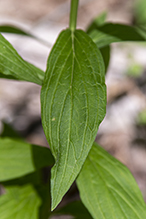 |
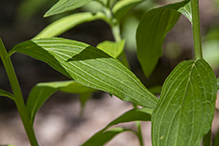 |
||||

Slideshows |
||

Visitor Videos |
|||
Share your video of this plant. |
|||
| This button not working for you? Simply email us at info@MinnesotaSeasons.com. Attach a video, a YouTube link, or a cloud storage link. |
|||
Other Videos |
|||

Visitor Sightings |
|||||
Report a sighting of this plant. |
|||||
| This button not working for you? Simply email us at info@MinnesotaSeasons.com. Be sure to include a location. |
|||||
| Luciearl 9/22/2020 |
Location: Owatonna, MN Found this plant yesterday growing on the trail near Mineral Springs Pk., Owatonna. |
||||
MinnesotaSeasons.com Sightings |
|||||

Created: 10/17/2020
Last Updated:
